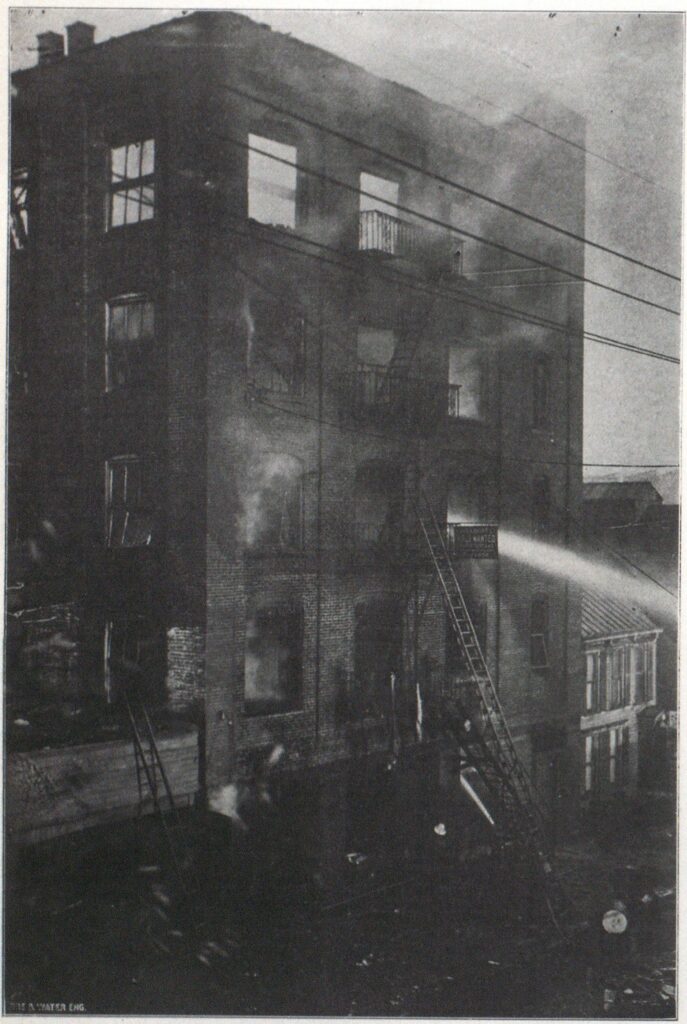
THE WILLIAMSBURGH DISASTROUS FIRE
The disastrous fires in Peabody, Mass., and Wiliamsburgh, Brooklyn, in which more than twenty-five lives were lost, besides the more than one hundred people injured, will awaken widespread interest to the importance of proper supervision against fire in buildings of this character where many human beings congregate every day. These fires were simply repetitions of others of a similar character that have occurred in recent years and which then aroused great public feeling in all parts of the world. The investigations and suggestions that followed these fires showed that v ant of proper safeguards to protect life was principally the cause of the disasters, but no very radical method to prevent them was, or probably could be, adopted. Defects in fire escapes, in fireproofing, in internal manage ment all received attention and were discussed from both secular and scientific standpoints, yet following the lesson taught by the Triangle fire in New York City in 1911, two public buildings, a school and a factory were destroyed within a few days of each other, with astonishing rapidity and consequent loss of life. The story of the Williamsburgh disaster of Saturday last is pitiful as showing that eight lives might have been saved if the lower part of the fire escape could have been lowered in time to let the people crowded on it descend to the ground. There were one hundred and seventy-five men and women working at various trades in the building when the fire started at the foot of a staircase leading from the ground floor to the upper stories. It burned with such rapidity that the discipline developed by years of fire drills went to pieces. Ninety per cent, of those in the building rushed for the single fire escape in front, with the result that the jam was so great that dozens of them were toppled over the rails to the sidewalk below. Twenty or thirty who managed to get down the ladders to the first floor balcony were unable to unhook and set the last ladder, which reaches to the street, and were overcome in one large heap by the smoke and flames. When firemen finally reached them eight were dead and it was with the greatest difficulty that the others were revived. Very little order was maintained, otherwise at the first alarm everybody in the building could have been saved. The emergency stairway at the extreme opposite end of the building from where the fire started afforded ample means of escape, but comparatively few of those in the building used it, making for the already overcrowded fire escape or jumping from windows instead. The windows on the sides of the building were of the folding pattern, opening at right angles to the frame. When so opened there is very little room for a person to squeeze through. Firemen who reached these side windows by using scaling ladders were unable to get through them or save those inside. The firemen arrived promptly, but were somewhat delayed by the policeman who discovered the fire not knowing a fire alarm box was at one corner of the building and ran to another more than a block away. Deputy Chief Tally was early on the scene and directed the efforts of the men to save the lives of the people, but the task was a difficult one as many of them were beyond control. No matter what may be the result of the investigation now going on it ought to be made imperative that the owners of such structures as that at Williamsburgh should provide fire exits to enclosed fireproof escapes. Partition walls with iron doors can be used in all factory buildings so that employees may be shut off immediately from the compartment where a fire occurs and an enclosed brick or stone fire escape will afford absolute safety in retreat. Factory inspectors in the present case had notified the owners to line the walls with tin and this work was progressing when the fire broke out. It must be remembered that fires of this kind occur among the contents in the buildings, not in the walls, and that sprinkling systems are valuable in extinguishing them, but to afford ample protection to inmates the partition walls must be of fireproof construction and capable of being instantly closed by fire doors. When factories are so provided it will do away with panics and the great loss of life following fires.


